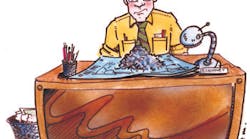A Hole in None
About 30 years ago, one of my first assignments as a young electrical engineer was to make a test stand for some new telephone switches. The test stand included a part that was little more than a 3-inch length of round aluminum bar with a hole running through it lengthwise. Being an engineer, I made a drawing that showed the front, back, and side views of the part before proudly giving it to the machine shop for fabrication. A couple of days passed before the machinist brought the “part” back to me. After setting the drawing down and depositing a handful of aluminum shavings on top of it, he pointed to the drawing and laughed all the way back to the shop. In my haste, I had specified a 0.5-inch hole in 0.25-inch stock instead of a 0.25-inch hole in 0.5-inch tock.
William Liddie
Grand Rapids, Mich.
Head Case
On an industrial job at a log processing operation, one of my fellow electricians was always griping about how uncomfortable it was to have to wear his hard hat, and he took every opportunity — breaks, lunch, etc. — to remove it. One day he took a break under the structure of a log conveyor. He threw the hard hat to the ground and challenged anyone to make him put it back on since he was on his break and not working. Upon finishing, he stood up and promptly cracked his head on the intersection of the structural X-brace above where he had been sitting. Fortunately, he suffered only a bump on the noggin, but we never had any further complaints from him about wearing the hard hat.
Russ Hogelin
Centreville, Ala.
Illustrations by Clint Metcalf



